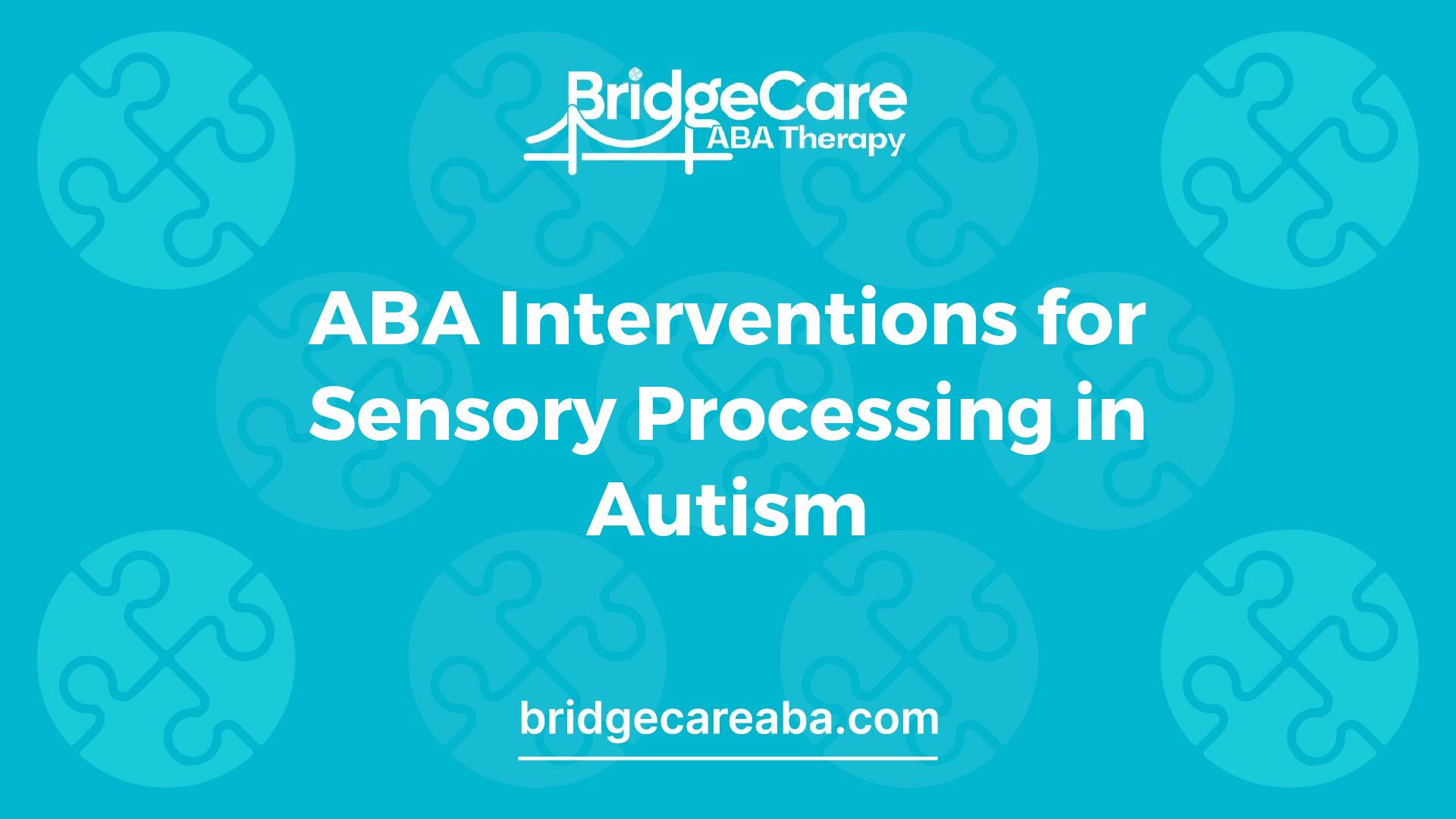ABA Interventions for Sensory Processing in Autism
Discover how ABA for sensory processing in autism can enhance self-regulation and improve outcomes for individuals.
ABA Interventions for Sensory Processing in Autism
Discover how ABA for sensory processing in autism can enhance self-regulation and improve outcomes for individuals.
Understanding ABA Therapy
Applied Behavior Analysis (ABA) therapy has gained recognition as an effective method for addressing various challenges associated with autism spectrum disorder (ASD). Understanding its history, principles, and therapeutic techniques can help parents and caregivers navigate the support options available.
History and Principles
Therapists have utilized ABA to assist children with autism and related developmental disorders since the 1960s. ABA is grounded in behavioral psychology, focusing on the function of behaviors and modifying them through reinforcement techniques. The primary aim is to enhance socially significant behaviors while decreasing those that are harmful or disruptive.

ABA therapy is defined under the standards set by the Board Certified Behavior Analyst (BCBA), Board Certified Assistant Behavior Analyst (BCaBA), and Registered Behavior Technician (RBT) Task Lists [2]. This structured approach ensures that interventions are scientifically validated and tailored to the individual needs of children with autism.
ABA principles emphasize:
Therapeutic Techniques
ABA therapy incorporates various therapeutic techniques designed to promote learning and independence in individuals with autism. Some core techniques include:
TechniqueDescriptionDiscrete Trial Training (DTT)Breaking skills into small, manageable components for teaching.Pivotal Response Training (PRT)Focusing on pivotal areas to develop broader skills, enhancing motivation.Natural Environment Teaching (NET)Using natural settings and activities to reinforce learning in real-life contexts.Social Skills TrainingDeveloping interpersonal skills through role-playing and guided practice.
Recent studies indicate that ABA methodology can significantly improve skill performance in children diagnosed with autism, particularly in academic, social, and daily living skills [3].
ABA is particularly effective in addressing sensory processing challenges that individuals with autism commonly face. Research shows that over 96% of children with ASD report hyper and hypo-sensitivities in multiple sensory domains, impacting daily functioning [4]. Integrating ABA techniques to target these sensory processing issues can be instrumental in developing coping strategies and enhancing overall quality of life.
For parents and caregivers, understanding these aspects of ABA therapy is essential for making informed choices about behavioral interventions for their children. Additional resources on ABA therapy for autism support services and ABA therapy for autism family programs may provide further guidance.
ABA Therapy for Autism
Improving Outcomes
Applied Behavior Analysis (ABA) has been widely recognized for its effectiveness in improving outcomes for individuals with autism. More than 20 studies have established that engaging in intensive and long-term therapy using ABA principles can lead to significant gains in various domains, including intellectual functioning, language development, daily living skills, and social functioning.
One notable study conducted in Brazil assessed the impact of ABA methodology on 16 children diagnosed with autism spectrum disorder (ASD). The results showed that children experienced improvements in skill performance across academic, social, and daily living skills [3]. The table below summarizes the areas where improvements were most evident:
Skill DomainLikelihood of Independent PerformanceAcademic SkillsHighSocial SkillsModerateActivities of Daily LivingModerate
The findings reinforce the potential of ABA therapy to enhance the daily lives of children with autism, enabling them to perform tasks more independently. This effectiveness aligns with the goals of ABA therapy for autism support services, aimed at fostering essential life skills. For additional resources on this topic, refer to our information on ABA therapy for autism support services.
Medicaid Coverage
Access to ABA therapy for children diagnosed with autism is supported by Medicaid coverage in the United States. All Medicaid plans must cover treatments deemed medically necessary for children under the age of 21. This includes ABA therapy if it has been prescribed by a qualified healthcare provider [1].
This coverage is vital for families seeking therapeutic interventions for their children, as it helps alleviate the financial burden associated with intensive and specialized therapy. Parents can take advantage of this coverage to ensure their child receives the necessary support through appropriate ABA therapy for autism family programs and services.
In summary, ABA therapy provides substantial benefits for children with autism, improving various skills essential for everyday life, while Medicaid coverage facilitates access to these critical services. For more information on improving outcomes, refer to our article on ABA therapy for autism family services.
Sensory Processing in Autism
Prevalence of Sensory Issues
Sensory processing issues are extremely common in individuals with autism, with estimates indicating that between 90% to 95% of those with autism spectrum disorder (ASD) experience such challenges [5]. A significant number of children with ASD exhibit atypical sensory-based behaviors, including both hyper-sensitivity (over-responsiveness) and hypo-sensitivity (under-responsiveness) to sensory stimuli.
The following table summarizes the prevalence of sensory issues among children with ASD:
Sensory Processing Disorder (SPD)Prevalence Rate (%)General prevalence in ASD90-95Reporting hyper/hypo-sensitivitiesOver 96SPD prevalence among children with ASD42-88
These sensory behavioral differences can vary in severity from mild to severe and are often experienced throughout adulthood. Sensory issues are explicitly included in the diagnostic criteria for autism, which acknowledges the unique sensory sensitivities of each individual.
Impact on Individuals
The impact of sensory processing issues on individuals with autism can be profound. Many children with sensory processing dysfunction encounter difficulties in regulating their responses to sensory stimuli, often leading to poor sensory integration, attention challenges, and issues with arousal. As a result, individuals may exhibit behaviors that are misunderstood or challenging during daily activities.
Sensory sensitivities can affect various aspects of life, including communication, social interactions, and learning environments. The following consequences illustrate the range of impacts on individuals:
Addressing these sensory challenges is critical for improving overall quality of life and outcomes for individuals with ASD. Implementing ABA interventions focusing on sensory processing can support better emotional regulation, adaptive behavior, and social engagement. For further information on ABA therapy for autism, including family services and support, visit our dedicated resources.
ABA Strategies for Sensory Processing
Addressing sensory processing challenges in individuals with autism is essential for promoting emotional regulation and overall well-being. Applied Behavior Analysis (ABA) presents several strategies that can significantly enhance sensory processing capabilities.
Self-Regulation Skills
One of the principal benefits of ABA therapy is its emphasis on developing self-regulation skills. These skills are crucial for helping children with sensory processing difficulties manage their emotional responses to various sensory challenges. For instance, ABA techniques can train individuals to recognize signs of sensory overload and utilize coping mechanisms to manage their feelings.
Self-regulation skills may include:
Self-Regulation SkillDescriptionIdentifying TriggersRecognizes specific sensory stimuli that cause discomfort.Breathing TechniquesUtilizes deep breathing exercises to promote calmness.Sensory BreaksAllows for rejuvenation in a controlled sensory environment.
Desensitization Protocols
Desensitization protocols involve gradual exposure to sensory stimuli that might typically provoke anxiety or discomfort in individuals with autism. This method aims to reduce sensitivity over time, thereby increasing tolerance and comfort with various sensations.
Steps in desensitization may include:
Individuals may have deficits in multisensory integration, affecting how they filter or process simultaneous inputs across auditory, visual, and tactile domains [4]. Desensitization aids in enhancing these processing skills while reducing associated anxiety, making it a crucial component of ABA strategies for sensory processing in autism.
For parents and caregivers, implementing these strategies can create a supportive environment that helps individuals navigate sensory challenges more effectively. Learning to integrate self-regulation and desensitization skills into daily routines can transform the quality of life for those impacted by sensory processing issues. For further resources, explore our page on aba therapy for school success in autism or delve into how reducing aggressive behavior with aba can complement these strategies.
Sensory Integration in ABA
Positive Effects of Sensory Integration
Sensory Integration (SI) interventions play a crucial role within ABA therapy for autism. These strategies focus on helping individuals manage sensory inputs more effectively. Research indicates that children who participate in SI interventions exhibit significant improvements in their ability to process sensory information.
Improvement AreasPercentage of Children AffectedSocial Responsiveness70%Decrease in Autistic Mannerisms60%
Children receiving SI therapy demonstrate enhanced social responsiveness and a notable decrease in autistic mannerisms compared to their peers who do not engage in these interventions [8]. Such results underscore the effectiveness of incorporating sensory strategies into ABA therapy, which can lead to positive behavioral outcomes.
Enhancing Social Responsiveness
Integrating sensory strategies into ABA therapy not only assists with sensory processing challenges but also significantly enhances social interactions. When caregivers and therapists modify the environment through sensory breaks or specific interventions, it creates a supportive space where individuals feel comfortable to engage and communicate effectively [9].
Effective sensory integration allows children to reduce anxiety related to sensory overload, thus facilitating smoother social interactions. For example, sensory-friendly environments that consider lighting, sound, and texture can significantly improve how children socialize with peers. Parents and caregivers can explore various ABA therapy for autism support services to better understand how these techniques can be leveraged for optimal outcomes.
Collaborative Approach in ABA
Caregiver Involvement
Caregiver involvement is essential in the implementation of ABA for sensory processing in autism. ABA therapists collaborate closely with caregivers and families to share insights and strategies that can be applied at home. This collaboration creates a consistent and supportive sensory environment beyond therapy sessions, reinforcing the effectiveness of interventions.
Research has shown that when caregivers actively engage in the therapeutic process, children with autism can experience improved outcomes. This is achieved through regular communication between caregivers and therapists, fostering an environment that promotes the generalization of skills learned during therapy. Families are encouraged to become active participants in identifying sensory triggers and developing tailored strategies to help their loved ones cope.
Role of CaregiversImpactActive ParticipationPromotes skill generalizationCommunication with TherapistsEnhances intervention effectivenessIdentifying Sensory TriggersTailors strategies for individual needs
Supportive Sensory Environment
Creating a supportive sensory environment is another critical aspect of ABA interventions. A well-structured environment can significantly affect the individual's ability to process sensory information and manage sensory-related behaviors. ABA therapists work with caregivers to design environments that reduce sensory overload and promote comfort.
This can include various adjustments, such as altering lighting conditions, minimizing background noise, and incorporating calming elements like soft textures or weighted blankets. The goal is to create an atmosphere where the individual feels safe, which can lead to enhanced coping mechanisms and reduced distress during sensory experiences.
It is crucial for caregivers to understand that sensory processing challenges can impact behavior, emotions, and overall well-being. By implementing sensory-friendly strategies at home, caregivers can support their loved ones in navigating the world more effectively and improve their overall quality of life.
Environment AdjustmentsBenefitsReduced sensory overloadIncreased comfortCalming elementsEnhanced coping mechanismsTailored sensory inputsImproved emotional regulation
The collaborative approach in ABA not only strengthens the relationship between caregivers and therapists but also empowers families to be proactive in creating supportive environments that enhance the effectiveness of ABA interventions. For more insights on effective family involvement, refer to ABA therapy for autism family programs.
References
[2]:
[3]:
[4]:
[5]:
[6]:
[7]:
[8]:
[9]:
[10]:







